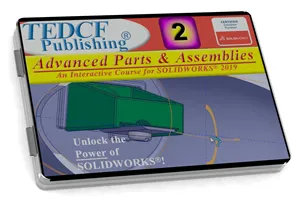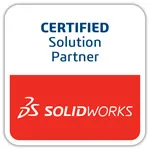Take Your Skills to a New Level!
The SolidWorks 2019: Advanced Parts & Assemblies course is the second course in the series. It expands your knowledge of solid modeling to include faster and more advanced methods. It covers the details of creating assemblies and shows several advanced methods of creating them. By the time you finish this course you will be an advanced modeler.
The course starts by showing you how to work with materials and how to create your own custom materials. As you might have guessed, materials are an important aspect of your models and assemblies. Controlling materials can make your models look more realistic. Materials are revisited throughout the course to help you excel in this area.
Most 3D models use standard threads on their models, which is simply a 2 dimensional image wrapped around a cylindrical feature. It really doesn't look like a real 3D thread. You, however, will learn how to create 3D helical threads. It takes just a little longer than 2D image threads, but it really makes your models stand out.
You'll also gain an extensive insight about configurations. Configurations are used to create different versions of a part. For example a cast part becomes a completed part after it's been machined. So there are two phases in producing a cast part. First it's cast, and then it's machined. You can create a cast configuration complete with its specifications, and then create a machined configuration from the cast configuration. Each configuration will have its own specifications and created in the shortest time possible. This course shows you how this is done.
Design tables are also powerful tool used to create part generators. Excel worksheet can be used to generate an entire family of parts and all you need to do is construct one part. There are an endless number of benefits you can achieve using this tool.
If you're a guru with mathematics you can also use equations to generate features. This requires some basic knowledge of algebraic equations, but it's covered in this course. It's also shown in a way that simplifies the process so most modelers will learn to enjoy using equations to control features.
Welments are also covered. You'll learn how to customize joints in a frame member, add gussets and caps, as well as weld beads. This course covers it all while showing best practices and sound procedures.
All the standard and advanced mates are covered in detail. You'll practice using each one while exploring their strengths and weaknesses. Each step of the way you'll learn best practices for creating robust assemblies.
Assembly and design strategies are also covered in detail. You'll practice creating assemblies using bottom up and middle out design strategies. You'll create assemblies from single part files using top down design and multi-body modeling. You'll also practice using hybrids of each strategy.
By the time you finish this course you will know advanced methods of creating models and assemblies. You'll have practiced using sound practices and procedures, and you truly understand what it takes to create professional models and assemblies.
81 Lessons (Listed Below)
7.9 hours of instruction
Browse through the lessons from the following SolidWorks 2019 courses and watch sample lessons.
SolidWorks 2019: Professional Modeling SolidWorks 2019: Advanced Parts & Assemblies SolidWorks 2019: Mechanical Drawings SolidWorks 2019: Sheet Metal Design SolidWorks 2019: FEA Made SimpleOur SolidWorks courses require No Installation. You can watch them on any device connected to the internet.
You will receive an email containing your User Name and Password. Login to your account and start learning. It's that easy.
While you're logged into your account you can download files used in the courses, watch lessons, and practice the tasks taught in the lessons. Keep in mind that you will use your installation of SolidWorks® to practice.
Get your SolidWorks® 2019 training now. You can start learning in minutes.
SolidWorks® 2019:
Advanced Parts & Assemblies
No Installation Required
Watch from any device connected to the internet.

$54.95 - $109.95
Watch Sample Lessons
Watch the first hour of the Professional Modeling course for SolidWorks 2019.
 Click to Watch!
Click to Watch!Advanced Parts & Assemblies
7.9 hours of instruction
Lessons
Introduction
Files and Folders
Custom Materials
Mastering Materials
Custom Color Swatches
Intro to Custom Appearances
Creating Helixes
Helical Threads
Limits to Reusing Sketches
RealView and Scene Display
Introduction to Configurations
Add Configurations
Machined Versions
Comparing Configurations
Configuration Parameters
Material Configurations
Setting Surface Materials
Updating Template Configurations
Derived Configurations
Cast Configurations
Machined Configurations
Parent Child Configurations
Derived Material Settings
Introduction to Design Tables
Design Table Parameters
Parameter Syntax
Blank Design Tables
Select and Rename Dimensions
State Design Table Parameters
Reduce Design Table Memory I
Reduce Design Table Memory II
Importing Excel Files
Introduction to Equations
Equations and Configurations
Feature Parameter Equations
Conditional Statements
Equations and Design Parameters
Direct Input Equations
Custom Assembly Templates
Introduction to Weldments
Modifying Joints and Members
Trim Extend Members
End Caps
Gussets
Weld Preparations
Exporting Bodies to Assemblies
Fillet Weld Beads
Weld Strategies
Intermittent Welds
Custom Libraries
Custom Profiles
Using Custom Profiles
Degrees of Freedom
Understanding Mate Errors
Mate Type Errors
Mate Strategies
Width Mate
Symmetric Mate
Linear Coupler Mate
Advanced Distance Mate
Advanced Angle Mate
Organizing Assembly Components
Bottom Up Design
Linear Component Pattern
Shortcomings of Bottom Up Design
Middle Out Design
Creating Sub Assemblies
Adding the Toolbox
Building Sub Assemblies
Create Parts from Surfaces
Effective Smart Mates
Advanced Assembly Aspects
Projecting Curves to Surfaces
Cutting With Surfaces
Assemblies into Parts
Using Inserted Parts
Linked Part Files
Details of External References
Split Part Best Practices
Strategy for Multi-Body Modeling
Conclusion
